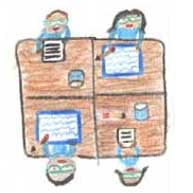Action Research: Example from an ESL Classroom

Mr. B wanted to better understand the experiences his ninth grade ESL science students had with learning science in order to provide them with more relevant and effective instruction. Because of their diverse backgrounds, he thought drawings might serve as a rich data source not limited by English language skills. He also knew that drawing would be enjoyable for his students and could serve to get them talking about science. With his five-year performance review coming up, he wanted to have additional content for his portfolio, and action research would be a valuable addition.
Action Research Question
He started with the research question, "What are the experiences of my ESL students with science?" After reviewing the literature using Google Scholar, he modified his question to be more specific. His new question was "What experiences do my ninth grade ESL students have learning science prior to entering my class?" He also added the question, "To what extent do my learners (and my science teaching) show evidence of 21st-Century recommendations for science education made by the US National Research Council?"
Research Plan
His plan was to collect drawings from students in each of his ESL science classes in response to the prompt "Draw yourself learning in science before coming to this country." Mr. B also asked students in his non-ESL classes to draw themselves learning science to allow for a comparison. In order to strengthen his research, he also planned to use additional sources of data. This included having students describe what they drew in writing on the back of their drawing and conducting interviews with five students about their experiences.
To guide his research Mr. B decided to use social constuctivism as a conceptual framework (or theory of understanding) because of its focus on social and cultural aspects of learning.
To analyze and interpret the data, Mr. B planned to use the rubric found on this site. To help reduce any bias he asked a fellow teacher to also score the drawings using the rubric. This also gave him the opportunity to collaborate and discuss his research with another educator.
In addition to modifying his own instruction, Mr. B planned to share the results of his research with other teachers in the science department at their monthly meeting and with other ESL teachers in the school.
Return to Action Research Examples
Next Section: Action Research Topics and Questions
Return to Action Research Home

